Page D
(Study of Threes)
http://threesology.org
Researchers as of 11/20/2019
| 3-to-1 ratios page A | 3-to-1 ratios page B | 3-to-1 ratios page C | 3-to-1 ratios page D |
| 3-to-1 ratios page E | 3-to-1 ratios page F | 3-to-1 ratios page G | Three to One Fundamental Forces |
Here are other examples of 3 to 1 ratios taught to children... (The last two are repetitions of previous inclusions):
- Papa bear- Mama bear- Baby bear- Goldilocks
- Lion- Tin man- Scarecrow- Dorothy
- 3 Little Pigs and 1 Big Bad Wolf
- 1- All around the cobbler's bench
- 2- The monkey chased the weasel
- 3- The monkey thought 'twas all in fun
- (Pop -- goes the weasel!)
- 1- Johnny's got the whooping cough and
- 2- Mary's got the measles
- 3- That's the way the money goes
- (Pop -- goes the weasel!)
- 1- Happy Birthday to you
- 2- Happy Birthday to you
- Happy Birthday dear ...
- 3- Happy Birthday to you
- One for the money-
- Two for the show-
- Three to get ready-
- ["and"] Four to go.
Distinct
three-part examples of the (game) running expression are:
1- On (or to) your marks-
2- Get set (or Ready set)-
3- Go!
Here is a much used abbreviated variation: Ready- Set- Go!
On several occasions I have encountered mothers telling their children to do something by the count of three.
3 to 1 ratio of alien types commonly found in the area of alien research:
- 1- The Greys (portrayed with a triangular or egg-shaped head)
- 2- The Reptilian form (portrayed with a triangular-shaped head)
- 3- The Insect-like form (portrayed with a triangular-shaped head)
- The Nordics.
It is this last form which is characteristically portrayed as being most human-like. However, if humanity started out as a simple organism, it could be speculated that the above forms are vestigial reflections of a previous lineage, with the Greys either as a very distant initial origin or a reflection of that yet to come. If humanity did start out biologically more simple than current evolution theory suggests, we will need to locate a missing link between plant and say, insect, as well as say, between insect and reptiles. The Nordics are images of an Indo-European past, but it would be interesting to identify whether any non-Indo-European has had such an image come to mind.
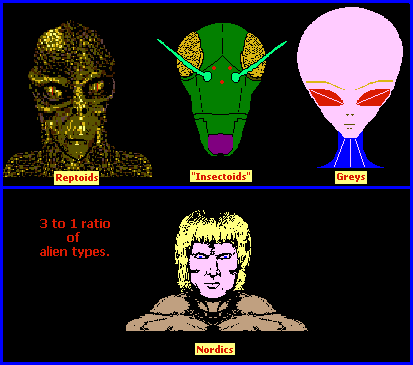
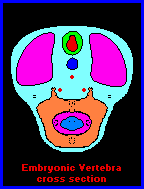
As an aside note for those researchers who are not fearful of divergent correlations, take a look at the similarity between the above triangular-shaped images of aliens and the shape of an embryonic vertebra in cross-section. Additionally, notice that there are 3 small triangularly positioned "spots" in between the eyes of the insect and 3 "spots" on the vertebra. If we include the notion of "three eyes" to some alien forms (such as the Greys), since some aliens are said to exhibit a third eye, we have another correlated "three" reference. |
Here is a combined form of the 3 to 1 and the 3:
Rich man - Poor man - Beggar man - Thief (we do not say "Thief man")Doctor - Lawyer - Indian Chief
Some observers may want to label the above example as a "7." They then may want to look at other examples of the "7" and (typically) partition them into examples of the 3 and 4, even though other numerical relations are available to be used.
Here is another example of the "7" that is historically referred to as a 3/4 complementarity:
Arithmetic - Geometry - Music - Astronomy (labeled the Quadrivium)Grammar - Rhetoric - Logic (labeled the Trivium)
3 days of the week named after planets (The other four are named after Norse gods):
- Sunday (day of the Sun): worship of the Sun-
- Monday (day of the Moon): veneration of the moon-
- Saturday (day of Saturn): Roman god worship
...and here's the 4-part section which begins on the 3rd day of the week (The supremacy of the Sun was given the first day of the week. Second in honor was the Moon's day, now called Monday):
- Tuesday- Norse mythology: Tyr/Tiu/Tiw's day- (god of war and strife and son of Odin)
- Wednesday- Norse Mythology: Woden/Odin's day (he was the chief god)
- Thursday- Norse Mythology: Thor's day- (god of thunder and rain and farming and son of Odin)
- Friday- Norse Mythology: Freyja/Frey's day (Freyja was goddess of love and fecundity and her brother Frey was god of Earth's fertility and peace and prosperity)
While not customarily referred to as a 3/4 representation of the "7," it may be of interest for some numerologist's to note that it has been frequently cited that the length of one turn of the helix is approximately 34 Angstroms (34Å) and the spacing between the bases is 3.4 Angstroms (3.4Å). (The exact length of one turn of the helix is said to be 35.7Å.) And for those wondering, there may not now nor ever existed an environmentally equivalent numerical arrangement to account for this value, as a pristine influence of its occurrence.
...let us also include the Christmas tree and ornaments as a symbolic representation of early astronomy:
- The triangular shape of the tree represents the triangular path of the Sun (or moon).
- The frequently used star atop the tree clearly represents stars overhead, or perhaps more specifically, a singular dominant star such as the North Star.
- The often used globe-shaped (glittering) ornaments can be viewed as miniature moons in different positions on the horizon.
With respect to the elements and biological life:
It is said that life consists mostly of four chemical elements: Carbon, Hydrogen, Oxygen, and Nitrogen... frequently referred to by the four letters "CHON." These four elements, (sometimes along with the elements Sulfur and Phosphorus,) are said to make up 99% of all living systems.
| Elemental Composition: | |||||
| Carbon | C | C | C | C | |
| Hydrogen | H | H | H | H | H |
| Oxygen | O | O | O | O | O |
| Nitrogen | N | N | |||
| Phosphorus | P | ||||
| Sulfur | S | ||||
| Component of Life:--- | DNA, RNA, ATP | Carbohydrate | Fat | Protein | Water |
| Organism Composition: | |||||
| Lettuce | 1.2 | 2.1 | 0.4 | 1.3 | 95% |
| Celery | 1.2 | 3.0 | 0.4 | 1.4 | 94% |
| Mushroom | 0.9 | 5.1 | 0.4 | 3.6 | 90% |
| Oyster | 2.1 | 2.4 | 1.5 | 6.0 | 88% |
| Codfish | 1.5 | 0 | 3.5 | 12.0 | 83% |
| Bacterium | 3.7 | 1.3 | 2.5 | 17.5 | 75% |
| Cow | 2.2 | 0 | 4.2 | 19.6 | 74% |
| Chicken | 1.8 | 0 | 11.0 | 21.2 | 66% |
| Pig | 2.7 | 0 | 20.2 | 20.1 | 57% |
3 "name" variations of the so-called four basic elements of life:
(The table data was adapted from page 107 of J. William Schopf's book "Cradle of Life.") | |||||
I propose that it may be more useful for the expansion of our understanding of life by describing this "four" (CHON) perspective into a 3-to-1 ratio view, or (with the addition of Phosphorus and Sulfur) into a 3 X 3 formula. It is quite easy to assign Hydrogen, Oxygen, and Nitrogen as gases, as well as assigning Carbon, Phosphorus, and Sulfur as minerals, even though we can find these elements in different representative states.
The usage of a "3" perspective would thus correlate well with the 3-patterned gaseous content constant on this 3rd planet: 78% Nitrogen~ 21% Oxygen~ 1% all other gases. (Carbon, Oxygen and Nitrogen [C, O2 and N) can form double and triple bonds which give them very peculiar properties).
If you ask the typical person to identify Oxygen, Nitrogen, Hydrogen, and Carbon as a solid, liquid, or gas, the first three are generally said to be gases while the last item (carbon) may not be readily known until you mention something like diamonds, pencil lead, bicycle frames, etc... In other words, it may not be referred to as a gas, but it may also not be referred to as a solid or liquid either, unless they simply make a guess.
The usage of a "four" perspective may in fact be a lingering remnant of a style of thinking used in antiquity such as we find in the concept of the four humors, the four basic substances (earth, water, fire, wind) and the four directions.
When we look at the toe arrangements of perching birds, we find that the most prevalent stance is the (anisodactyl) 3-to-1 ratio (of three toes in front and the (first digit) hallux pointing rearward) with the other two stances being an "X" and a "V" (and some may want to include the view that a "Y" is present):
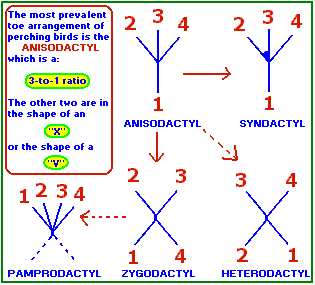
The solid arrows indicate the (presumed) evolution of this stance and the Dashed arrows indicate uncertain derivations. The syndactyl foot, (of the Coraciiformes) has the bases of toes 2 and 3 fused. The zygodactyl arrangement, with two forward and two rearward-pointing toes (which forms an "X,") has been achieved in different ways nine times during bird evolution. In trogons, toe 2, and not toe 4, is rear-directed (heterodactyl). In the pamprodactyl foot, the positions of toes 1 and 4 are not fixed; all four toes may point to the front (creating a "V" pattern).
Information and illustration adapted from page 53, of the Book "Ornithology" by Frank B. Gill, 1995.
Let us also include another 3 to 1 ratio example from the field of automotive servicing with respect to tire rotation. What we find is the usage of 3 crisscross patterns to 1 non-crisscross pattern, though there are individualized variations of tire rotation depending on whether an owner themselves is doing the work or a tire facility that is hired by the vehicle's owner. (In other words, the owner may be lazy and only change one tire with the spare and not rotate the entire set.):
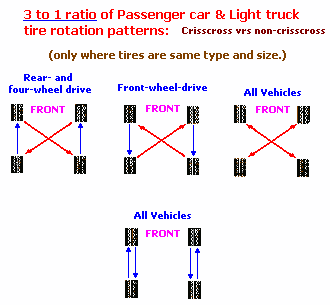
Notice also that there are 3 variations of crisscross pattern and 3 variations of the front/back pattern.
Advertisements in America frequently indicate that if you buy three tires you can get 1 free. (Meaning too much is being charged for each tire in the first place... and the tire rotation pattern(s) are meant to wear out all the tires at the same time so you have to replace all of them instead of just one or two if they were left in the same spot.)
*** Since the fertile life of the human egg cell lasts at most one day and that of the human sperm at most two days, there is a period of about three days during which copulation can result in conception (the day when the egg is fertile and the two preceding days).
*** Generally speaking, the egg traverses the fallopian tube in about 3 days; Sperm can travel at a rate of 3 inches per hour;
A spermagonium gives rise to 3 active cells and 1 resting cell.
When we look at RNA and DNA using the above "active and resting" criteria, we can see 3 "active" amino acids in the sense that they are mobile by occurring with both RNA & DNA, and 1 "resting" amino acid in the sense that they remain solely with RNA or DNA:
3 "active" {Adenine~ Cytosine~ Guanine} to 1 "resting" {Uracil} = RNA
3 "active" {Adenine~ Cytosine~ Guanine} to 1 "resting" {Thymine} = DNA
But even if you would prefer to say the obverse that there are 3 "resting" amino acids and 1 "active" amino acid, there would none-the-less be a 3-to-1 ratio.
3-part sleep pattern that is said to have been found in every warm-blooded creature on earth: Deep sleep ~ Light sleep ~ REM (Rapid Eye Movement associated with dreaming.)
3, 4, or 5 Cycles per night (though I have also read 4, 5, or 6 cycles), all of which last approximately 90 minutes in length (before repeating), is the frequency in which the stages of sleep are said to occur.(90 minutes is the typical length of a motion picture).
If we include the waking/consciousness state as a stage, we have six stages. With a five-stage reference, we have:
- Stages 1, 2, 3 as a group.
- Stages 4, 3, 2 as a group.
- REM (Rapid Eye Movement as lull point which signals the repeat of the stages sequence.
(After REM, the sequence repeats: 1- 2- 3- 4- 3- 2- REM 1- 2- 3- 4- 3- 2-...etc...
This simple counting sequence reminds me of the history of number usage by primitive peoples (and also the firing order of an internal combustion engine). If we add the waking/consciousness state, we have a 3 to 1 ratio configuration. It also brings me to the consideration of whether human society repeats a similar sequence, which would explain the repetition of war, of idiot politicians, inadequate social measures to effectively address the recurrences of poverty, criminal behavior, medical maladies, etc...)
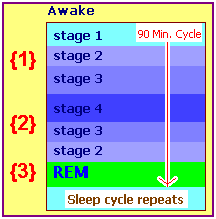
I am using colors to denote the different stages of sleep, with the darkest color representing "Deep" sleep as an analogy to the darkest color representing the deep part of an ocean as might be seen in an illustration that shows the different water depths by using differing colors...the lighter colors indicating shallower depths and the darker colors progressively showing deeper depths. What comes to mind when I view this is that the colors are representing some sort of colorized musical score. I also visualize this portrayal of sleep stages as a metaphorical representation of developmental biology in the early ocean so many billions of years ago. Life may very well had a fluctuating series of developmental stages at different depths of the ocean.
It is interesting to wonder whether our sleep cycle is a nightly recreation of our primordial development, just as our embryonic state is said to re-experience the development that the biological process of so many animals have passed through and yet come to diverge from the human blueprint in later developmental stages.(It is typically called "Ontogeny recapitulates Phylogeny," but has been re-phrased to reflect our present day understanding of early developmental processes:
For those who are unfamiliar with the concept, it is a theory formulated by Earnest M. Haeckel which states that individuals in their embryonic development pass through stages similar in general structural plan to the stages their species passed through in its evolution. In other words, the (embryonic) development of an individual (Ontogeny) is an abbreviated time-accelerated motion picture which shows the (embryonic) development of an individual species such as all vertebrates.
Below is a small representation of the embryonic stage of development of several species which do indeed exhibit a similarity:
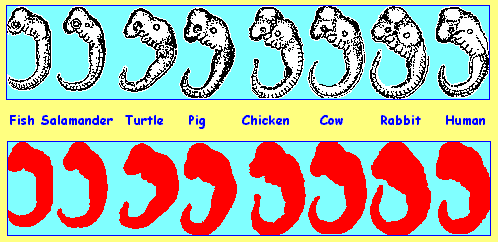
But not only does the sleep stage sequence remind me of the history of number usage of primitive peoples, it also reminds me of (overall 90 minute) sequences found in other areas. Here are a handful of correlations:
| 3 to 1 ratio:
These can be called the cyclical "moments" of the four stroke
engine. A four cylinder engine based on a 360 degree rotation is divided
into four 90 degree sections, while a six cylinder is 60 degrees and an eight
cylinder is 45 degrees. The American standard firing order for a four cylinder
water-cooled engine is 1-3-4-2, while the air-cooled Volkswagen, for instance,
uses a 1-4-3-2. With respect to current engine design, it is said that a 1-2-3-4
firing order would shake, rattle, and roll the engine and possibly tear it
from its mounts. Current engine design is in its infancy based on the analogy
that it uses a liquid, instead of a solid food diet.) Take a look at how the primivity of the 1- 2- 3- 4 numerical concept development can be applied to represent a philosophical perspective... (Notice that a reverse usage of it obscures its simplistic numerological origin.): The Hindu Yuga cycle is most definitely based upon the tetractys with a root number of 432 which is the tetractys ratio in reverse order, with the number 1 or unity dropped, viz: 1-2-3-4 reversed to 4-3-2-(1 dropped). Thus, the numbers of years in a Kali Yuga is 432,000 years and each successive Yuga adds to the ten-foldness of the Maha Yuga of 4,320,000 years. This sacred number 432 of the tetractys saturates ancient Hindu, Babylonian, Chaldean and Egyptian cosmological systems. For example, according to Berossus, the reign of the ten antediluvian kings in the Babylonian Marduck mythology was 432,000 years and this was called their "great year". In the Hindu RG VEDA, (the oldest written text) the 10,800 stanzas average forty syllables per stanza for a total of 432,000. In the geometry of Ptolemy, the diameter of his great circles is 432,000 and in his musical theory 432,000 is the least common denominator of his monochord fractions. http://www.vermontel.com/~vtsophia/SYM102a.htm |
| 3 to 1 ratio:
(Called the four seasons, with each season occurring approximately 90 days apart.) |
| 3 to 1 ratio:
(Called the 4, or 5, or 6 stages of sleep that occur every 90 minutes.) |
| 3 to 1 ratio:
(Called the four bases of the triplet genetics code. Is there an as yet unidentified 90-type of reference to the code?) |
| 3 to 1 ratio:
(Called the four intervals in music. [90...?]) |
| 3 to 1 ratio:
(Called the four blood types in the ABO blood typing scheme. [90...?]) |
| 3 to 1 ratio:
(Called the four parts/functions, hierarchal stages of the brain. [90...?] |
| 3 to 1 ratio:
(Called the four types of teeth. [90...?] |
| 3 to 1 ratio:
(Called the four parts of a News program that may occur in One 30- minute segment, Two 30- minute segments, or Many 30 minute segments during a national disaster.) |
Take a look at the following and compare the steps in this cycle with the cyclical pattern of sleep:
Determination of Mating Type by PCR (Polymerase Chain Reaction):
| Sleep cycle: | PCR cycle: | ||
| stage 1 | step 1 | 94°C | 4 min |
| stage 2 | step 2 | 94°C | 30 sec |
| stage 3 | step 3 | 52°C | 30 sec |
| stage 4 | step 4 | 72°C | 2 min |
| stages 4- 3- 2 | repeat step 2 to step 4 for 30 cycles | ||
| REM stage | step 5 | 72°C | 5 min |
Another 3 to 1 ratio example that is commonly seen by those using a shopping cart in the U.S., is a decal attached to the fold down child seat which provide safety rules for parents who place children into the basket while shopping. The following example was copied from a Toys R Us shopping basket, though I have seen a slightly different version on a basket used by Wal-Mart grocery stores. I have also seen a two decal variety as well as older carts which have no child safety rule decal whatsoever. On shopping baskets at Food-4-Less grocery stores, the same type of image as that shown below can be seen, except that there are 3 "No's" and 1 "Yes" below the captions:

I have seen three variations of the above rules displayed in 2, 3, and 4 (3 to 1 ratio) representation types on various shopping carts.
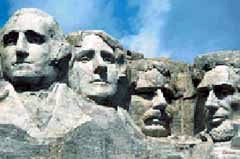 3 to 1 ratio of stone figure placements on Mount Rushmore:
3 to 1 ratio of stone figure placements on Mount Rushmore:- 1 of 3. George Washington
- 2 of 3. Thomas Jefferson
- 3 of 3. Theodore Roosevelt
- 1 of 1. Abraham Lincoln
Image source:--- Black and Veatch Service Projects ---
3 to 1 ratio of the four great guilds of major importance in 16th century Italy:
- 1 of 3. Cloth merchants (the Calimala)
- 2 of 3. Wool manufacturers (Arte della Lana)
- 3 of 3. Silk manufacturers (Arte della Seta)
- 1 of 1. The Bankers (the Cambio)
3 to 1 ratio of basic chemical reactions:
- 1 of 3. Synthesis
(composition)- two or more elements or compounds may combine to form a more
complex compound.
Basic form: A + X ® AX - 2 of 3. Decomposition- A single compound breaks down
into its component parts or simpler compounds.
Basic form: AX ® A + X - 3 of 3. Replacement- a more active element takes
the place of another element in a compound and sets the less active one free.
Basic form: A + BX ® AX + B or AX + Y ® AY + X - 1 of 1. Ionic- occurs between ions in aqueous solution. A reaction will occur when a pair of ions come together to produce at least one of the following:
- A precipitate.
- A gas.
- Water or some other non-ionized substance.
http://www.chem.vt.edu/RVGS/ACT/notes/Types_of_Equations.html
3 to 1 ratio perspective of different cloud types:
| Cloud Group | Cloud Base Height | Cloud Types | |
| 1 of 3. | High Clouds | Tropics: 6000-18000m mid-latitudes: 5000-13000m polar region: 3000-8000m |
Cirrus Cirrostratus Cirrocumulus |
| 2 of 3. | Middle Clouds | tropics: 2000-8000m mid-latitudes: 2000-7000m polar region: 2000-4000m |
Altostratus Altocumulus |
| 3 of 3. | Low Clouds | tropics: surface-2000m mid-latitudes: surface-2000m polar region: surface-2000m |
Stratus Stratocumulus Nimbostratus |
| 1 of 1. | Clouds with Vertical Growth | tropics: up to 12000m mid-latitudes: up to 12000m polar region: up to 12000m |
Cumulus Cumulonimbus |
http://www.windows.ucar.edu/cgi-bin/tour_def/earth/Atmosphere/clouds/cloud_types.html
3 to 1 ratio grouping of exceptions to the term "organic" (meaning that carbon is part of the molecule) but they are not organic molecules mainly because of their structure and lack of oxygen:
- 1 of 3. Diamonds
- 2 of 3. Coal/Oil
- 3 of 3. Graphite
- 1 of 1. Natural gas
3 to 1 ratio of Book of Mormon plates:
The Book of Mormon is claimed to be a sacred record of peoples in ancient America, and was supposedly engraved upon sheets of metal (as opposed to stone). Four kinds of metal record plates are spoken of in the book itself:
- 1 of 3.
The Plates of Nephi, which were of two kinds: the Small Plates and the Large Plates. The former were more particularly devoted to the spiritual matters and the ministry and teachings of the prophets, while the latter were occupied mostly by a secular history of the peoples concerned (1 Nephi 9:2-4). From the time of Mosiah, however, the large plates also included items of major spiritual importance.
- 2 of 3.
The Plates of Mormon, which consist of an abridgment by Mormon from the Large Plates of Nephi, with many commentaries. These plates also contained a continuation of the history by Mormon and additions by his son Moroni.
- 3 of 3.
The Plates of Ether, which present a history of the Jaredites. This record was abridged by Moroni, who inserted comments of his own and incorporated the record with the general history under the title "Book of Ether."
- 1 of 1.
The Plates of Brass brought by the people of Lehi from Jerusalem in 600 B.C. These contained "the five books of Moses,... And also a record of the Jews from the beginning,... down to the commencement of the reign of Zedekiah, king of Judah; And also the prophecies of the holy prophets" (Nephi 5:11-13). Many quotations from these plates, citing Isaiah and other biblical and non-biblical prophets, appear in the Book of Mormon.
Note: The presence of many patterns-of-three in the Mormon Religion is an historical record that the Religion is a later-born development (of human cognitive development), just like the presence of a multitude of patterns-of-three in the New Testament as opposed to fewer "threes" examples in the Old Testament. This later-born development of an increased "threes" usage can also be seen in the greater prevalence of "threes" in America (with its origins as a newer British colony) in contrast to fewer threes used in (the older) Britain. However, such distinctions can also occur amongst individuals in families or social groups even though the larger society may seem to be particularly void of a "threes" usage in a variety of areas.
3 to 1 ratio (abstract) view of shamrock:
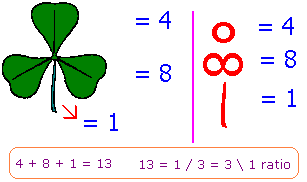
The "petals" of the "lucky" (four-leaf clover) Shamrock are viewed as portions of a figure-of-eight (instead of being 3-pointed triangles resulting in a 3 X 3 = 9 configuration) and the stem is analogously identified with the number 1. No less, since the Shamrock is sometimes interpreted to be a symbolic gesture of the Christian trinity, some may want to interpret the "13" as a 3 to 1 ratio portrayal in terms of the 3 persons in 1 God representation. (Typically, the shamrock is of the three-leaf variety.)
3 to 1 ratio of general watermelon categories of the more than 50 varieties found in the U.S.:
- 1 of 3. Allsweet- Red flesh
- 2 of 3. Ice-Box Red to Yellow flesh
- 3 of 3. Seedless Red to Yellow flesh
- 1 of 1. Yellow Flesh- Yellow to bright Orange flesh
3 to 1 word association associated with a guard on duty in the military:
Halt! Who goes there?
3 to 1 ratio hit pattern observed in volleyball:
- 1 of 3. Initial hit to teammate after ball is served by opposing team player.
- 2 of 3. Ball is hit back to first teammate.
- 3 of 3. First teammate hits it back in what some refer to as the setup position.
- 1 of 1. Second teammate typically hits (slams) the ball very hard over the net to the opposing team in an attempt to prevent them from returning the ball in a like- mannered way.
In glycolysis, two molecules of glyceraldehyde-3-phosphate are produced per (one) molecule of glucose.
(3- 2- 1) to 1 ratio for a particular type of concrete mix:
- 1 of 3. Three shovels of sand
- 2 of 3. Two shovels of stone
- 3 of 3. One shovel of concrete
- 1 of 1. Water added as needed to keep consistency moist but not wet nor too dry to insure bonding of materials.
Though the following example is related more-so to the "three," it contains an interesting reference of 3 and a half, which could be interpreted as a form of the 3 to 1 ratio:
Talking about "Three", when I think about it now, there are so many sayings and traditions etc. in Japan you will probably have to make a new category titled Threes in Japan. We have a lot of them related three. For example "it takes three days to be bored with a beautiful woman and/or to get used to an ugly woman". "Third time lucky" (you seem to have a similar saying according to my dictionary) (3do me no syoujiki). Those are sayings and there are even more I can remember now.
Someone said "Drink, Tissue paper, Condoms (things you buy at pharmacy) (*Drink meant here is a small bottle of liquid that you take when you need to be energetic.) Somehow we seems to have things of Three and Half. For example, when a wife leaves her husband, we say "she issued the/a three and half (3 kudari han -meaning a letter of three lines and half.) There is at least one more I can remember now which won't be mentioned in public communication device. This is interesting.
What you mentioned in Japan when people get married they finish drinking Japanese rice wine (sake) in three times is called "San san kudo". Why and when did you start to think about Three? If I may ask. To me, two is a couple, four is cloud or friends, and three is mysterious. And White, Red and Rose. I did this properly. Anyway although I'm rather a free woman, I have to go to bed. Talk to you soon. Oh one more thing. I don't know much about html or making your own homepage but can't you make this writing space a little wider? Or width, depth, and height if I remember correctly. Yumi-nyan
Note: The occurrence of "threes" in the Japanese must be analyzed through the lens of a cultural anthropologist to the extent it must be determined which, if any examples of the "three" in the Japanese culture are due to the influence of the American Occupation after World War II.
3 to 1 ratio portrayed as a "13" (as opposed to superstitious connotations) on the great seal of America?:
- 1 of 3 [objects]. 13 arrows clutched in one claw of the eagle (the other claw holds one olive branch, which some observers interpret as representing more inclination towards war than peace.)
- 2 of 3 [objects]. 13 red and white stripes, said to represent the original 13 colonies.
- 3 of 3 [objects]. 13 layers (steps) to the pyramid.
- 1 of 2 [words]. 13 letters to the phrase "Annuit Coeptis" (which means "a new order of the ages.)
- 2 of 2 [words]. 13 letters to the phrase "E pluribus unum" (which means "out of many, one.")
With America based on so many superstitions, it's easy to grasp why it can not endure.
3 to 1 expressions (or in the mode of a 1 to 3 ratio):
What, are you nuts?No, I got it
Page Created: Monday, June 24, 2013, 4:56 AM
Updated Posting: Wednesday, 20th November 2019... 6:47 AM
Herb O. Buckland
herbobuckland@hotmail.com